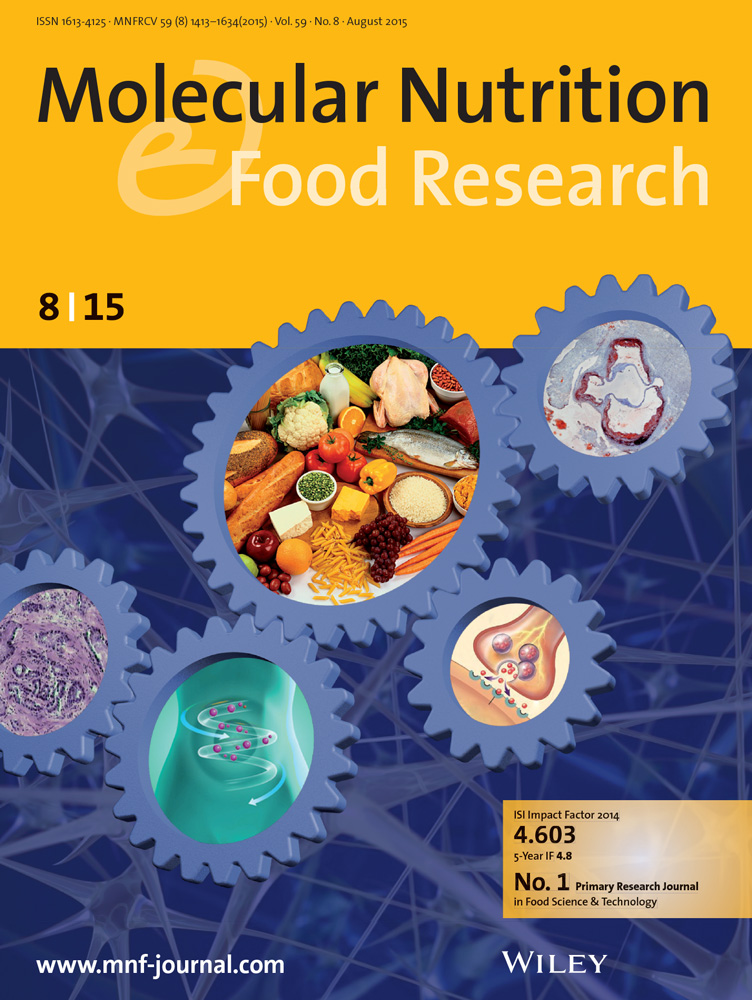健康和典型饮食模式的随机交叉试验中的代谢组学分析和饮食质量评分。
IF 4.2
2区 农林科学
Q1 FOOD SCIENCE & TECHNOLOGY
引用次数: 0
摘要
这项随机交叉喂养试验旨在确定饮食模式的客观代谢组学生物标志物,并评估它们与心脏代谢健康的关系。比较了两种不同饮食模式之间的代谢组学反应:基于国家指南的健康澳大利亚饮食(HAD)和反映表观人口摄入量的典型澳大利亚饮食(TAD)。为34名健康成年人提供每种饮食模式的所有食物,为期2周,其间有一个洗脱期。干预前后采集血浆和尿样,采用UHPLC-MS/MS进行代谢组学分析。弹性网回归鉴定出65种区分HAD和TAD的代谢物(31种血浆,34种尿液)。由这些代谢物得出的复合饮食质量生物标志物评分与心脏代谢标志物的改善显著相关,包括收缩压和舒张压、低密度脂蛋白胆固醇、甘油三酯和空腹血糖的降低。鉴定出的几种代谢物与已知的食物特异性生物标志物一致,而其他代谢物则代表了新的候选物。在不同的生物体液中观察到健康饮食模式的不同短期代谢组学特征。已确定的候选代谢物和生物标志物评分有潜力转化为客观工具,根据澳大利亚膳食指南评估饮食质量,并用于早期心脏代谢风险监测,有待独立队列的外部验证。试验注册:https://www.anzctr.org.au/Trial/Registration/TrialReview.aspx?id = 384710。本文章由计算机程序翻译,如有差异,请以英文原文为准。
Metabolomic Profiling and Diet Quality Scoring in a Randomized Crossover Trial of Healthy and Typical Dietary Patterns.
This randomized cross-over feeding trial aimed to identify objective metabolomic biomarkers of dietary patterns and assess their relationship with cardiometabolic health. Metabolomic responses were compared between two distinct dietary patterns: the Healthy Australian Diet (HAD) based on national guidelines, and the Typical Australian Diet (TAD) reflecting apparent population intake. Thirty-four healthy adults were provided with all food for each diet pattern for 2 weeks, separated by a washout period. Plasma and spot urine samples were collected pre-post-intervention, and metabolomic profiling was performed using UHPLC-MS/MS. Elastic net regression identified 65 discriminatory metabolites (31 plasma, 34 urine) that distinguished HAD from TAD. A composite diet quality biomarker score derived from these metabolites, was significantly associated with improved cardiometabolic markers, including reductions in systolic and diastolic blood pressure, LDL-cholesterol, triglycerides, and fasting glucose. Several metabolites identified aligned with known food-specific biomarkers, while others represent novel candidates. Distinct short-term metabolomic signatures of a healthy dietary pattern were observed across biofluids. The identified candidate metabolites and biomarker score have potential for translation into objective tools for assessing diet quality in line with the Australian Dietary Guidelines and for early cardiometabolic risk monitoring, pending external validation in independent cohorts. Trial Registration: https://www.anzctr.org.au/Trial/Registration/TrialReview.aspx?id = 384710.
求助全文
通过发布文献求助,成功后即可免费获取论文全文。
去求助
来源期刊

Molecular Nutrition & Food Research
工程技术-食品科技
CiteScore
8.70
自引率
1.90%
发文量
250
审稿时长
1.7 months
期刊介绍:
Molecular Nutrition & Food Research is a primary research journal devoted to health, safety and all aspects of molecular nutrition such as nutritional biochemistry, nutrigenomics and metabolomics aiming to link the information arising from related disciplines:
Bioactivity: Nutritional and medical effects of food constituents including bioavailability and kinetics.
Immunology: Understanding the interactions of food and the immune system.
Microbiology: Food spoilage, food pathogens, chemical and physical approaches of fermented foods and novel microbial processes.
Chemistry: Isolation and analysis of bioactive food ingredients while considering environmental aspects.
 求助内容:
求助内容: 应助结果提醒方式:
应助结果提醒方式:


